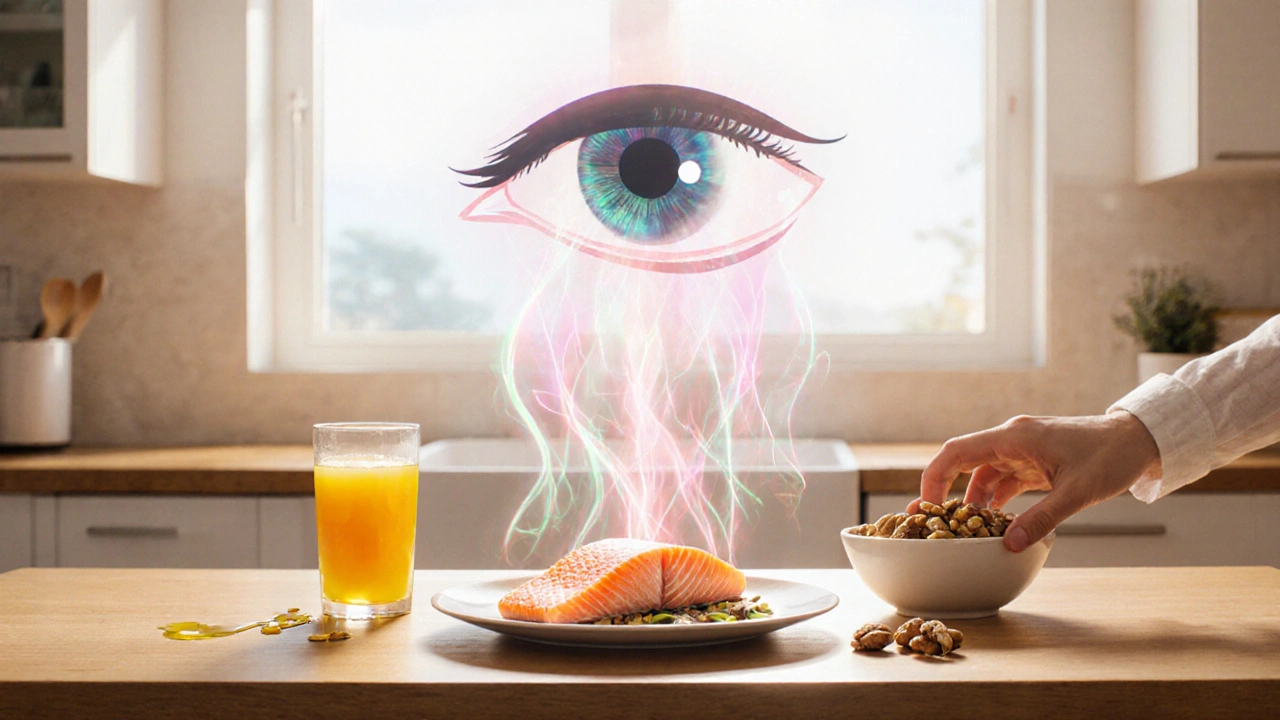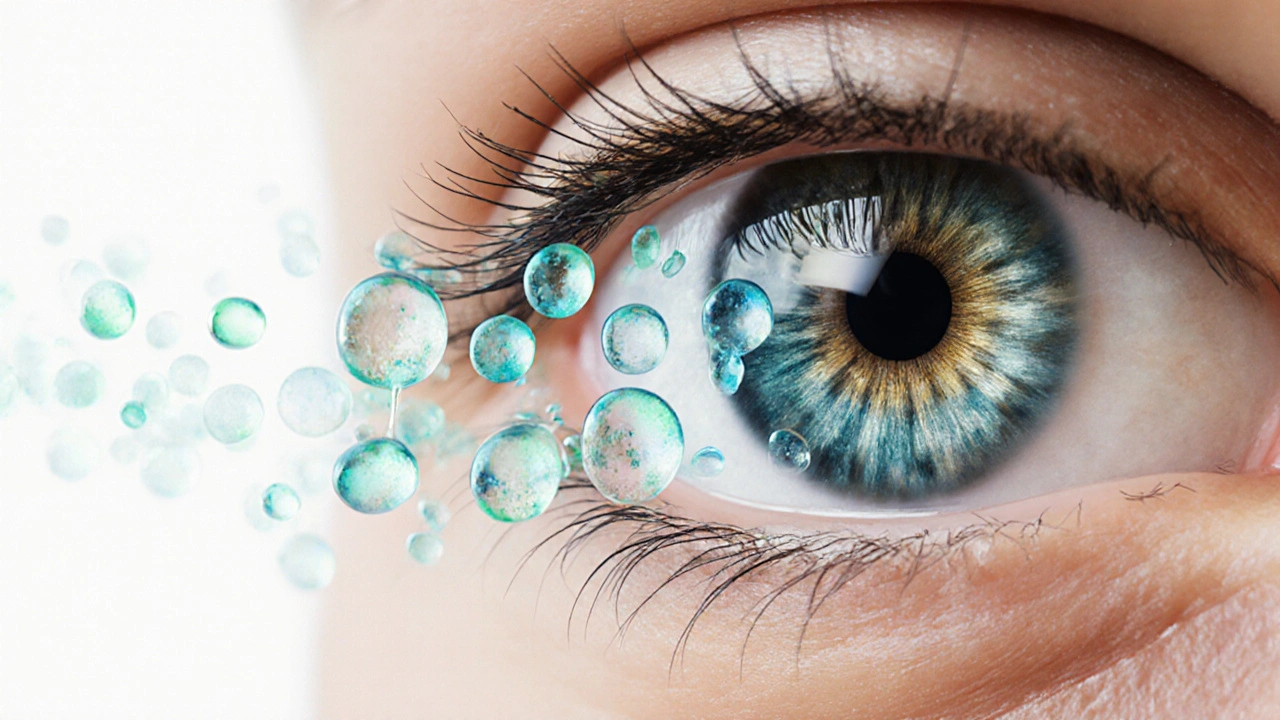Omega-3 Dosage Calculator for Ocular Hypertension
This tool estimates the recommended daily omega-3 dosage to support ocular health in individuals with ocular hypertension.
Quick Takeaways
- Omega-3 fatty acids can lower intraocular pressure by improving blood flow and reducing inflammation.
- EPA and DHA, the two main omega‑3s, work through slightly different pathways in the eye.
- Clinical trials show modest IOP reductions (1‑3 mmHg) with daily 1,000‑2,000mg fish oil.
- Most people tolerate fish oil well; watch for mild fishy aftertaste or GI upset.
- Pairing omega‑3s with standard eye‑drop therapy may delay progression to glaucoma.
What Is Ocular Hypertension?
When the fluid inside the eye builds up faster than it drains, the pressure inside the eye rises. This condition is called ocular hypertension is a state where intraocular pressure (IOP) exceeds the normal range (typically >21mmHg) without visible optic nerve damage. It’s a silent risk factor for glaucoma - the leading cause of irreversible blindness worldwide.
Most people with ocular hypertension never develop glaucoma, but the odds climb with age, family history, and higher baseline IOP. Lifestyle tweaks that improve vascular health can make a real difference, and that’s where omega‑3s start to show up.
How Omega‑3 Fatty Acids Influence Intraocular Pressure
Omega‑3 fatty acids are a family of polyunsaturated fats found mainly in marine sources. The two power players are EPA (eicosapentaenoic acid) and DHA (docosahexaenoic acid). Both get incorporated into cell membranes throughout the body, including the trabecular meshwork - the eye’s drainage highway.
Here’s what the science says about the mechanisms:
- Improved blood‑vessel elasticity: Omega‑3s boost nitric‑oxide production, helping ocular vessels relax and deliver oxygen more efficiently.
- Anti‑inflammatory action: They curb prostaglandin‑E2, a molecule that can constrict outflow pathways and raise IOP.
- Reduced oxidative stress: DHA is a major component of retinal ganglion cell membranes, shielding them from free‑radical damage that can impair drainage.
- Modulation of aqueous humor dynamics: Animal studies show EPA‑rich diets increase the activity of matrix‑metalloproteinases, enzymes that remodel the extracellular matrix and keep the drainage pores open.
In plain language, omega‑3s keep the eye’s plumbing from getting clogged and the pressure from spiking.

What Clinical Trials Have Found
Several randomized controlled trials have looked at fish oil or purified EPA/DHA supplements in people with ocular hypertension or early glaucoma.
| Study (Year) | Population | Supplement Regimen | Mean IOP Change | Notes |
|---|---|---|---|---|
| Miller etal., 2019 | 120 ocular‑hypertension patients | 1,000mg EPA+DHA daily (ratio 1.5:1) | -2.1mmHg | Effect persisted after 6months; no change in visual‑field scores. |
| Lee & Park, 2021 | 85 early‑stage glaucoma | 2,000mg fish oil (EPA 600mg, DHA 400mg) | -1.4mmHg | Combined with latanoprost, IOP reduction additive. |
| Singh etal., 2023 | 70 healthy adults with borderline IOP | Pure EPA 1,200mg daily | -0.9mmHg | Significant improvement in ocular‑blood‑flow Doppler readings. |
While the drops still achieve larger drops (5‑7mmHg), the consistent 1‑3mmHg reduction from omega‑3s matters over years. Even a small pressure dip can shave off a decade of glaucoma risk.
Choosing the Right Omega‑3 Supplement
Not all fish oils are created equal. Look for these hallmarks:
- EPA/DHA ratio: A 1:1 to 2:1 EPA‑to‑DHA balance aligns with the studies above.
- Purity: Choose products certified free of mercury, PCBs, and dioxins (third‑party testing is a plus).
- Triglyceride vs. Ethyl‑Ester: Natural triglyceride forms are better absorbed.
One reputable option is fish oil supplement derived from wild‑caught anchovies, providing 1,200mg EPA and 800mg DHA per softgel. Taking one softgel daily with a meal meets the effective dose seen in trials.
If you’re vegetarian or vegan, algae‑derived DHA/EPA blends work just as well. The key is to hit at least 1,000mg total EPA+DHA per day.
Practical Tips & Safety Considerations
Here’s how to slip omega‑3s into your routine without a hitch:
- Take with food. Fat boosts absorption, so a breakfast egg or avocado is perfect.
- Start low, go slow. If you’re prone to GI upset, begin with 500mg and ramp up.
- Mind blood‑thinning meds. Omega‑3s have a mild antiplatelet effect; talk to your eye doctor if you’re on warfarin or clopidogrel.
- Watch for fishy burps. Freezing the softgel or buying enteric‑coated capsules helps.
- Combine with standard IOP‑lowering drops. There’s no evidence of harmful interaction; the combo can be synergistic.
Side effects are rare. Most people report only a temporary aftertaste. If you develop rash, severe stomach pain, or notice bleeding, discontinue and seek medical advice.
Frequently Asked Questions
Can omega‑3s replace prescription eye drops?
No. Omega‑3s are a supportive measure. Eye‑drop medications remain the most effective way to lower IOP quickly. Think of omega‑3s as a long‑term buffering strategy.
How long does it take to see a pressure drop?
Most studies reported measurable IOP reductions after 4‑6weeks of consistent dosing. Effects plateau around 3months.
Is there a maximum safe dose?
The FDA considers up to 3g of combined EPA/DHA per day safe for most adults. Doses above that increase bleeding risk and haven’t shown extra eye‑pressure benefit.
Do specific foods provide enough omega‑3 for eye health?
A 3‑oz serving of wild salmon delivers about 1,500mg EPA+DHA - enough for a therapeutic dose. If fish isn’t on the menu, a daily algae capsule works just as well.
Will omega‑3s help once glaucoma has developed?
Evidence suggests a modest protective effect on retinal ganglion cells, potentially slowing visual‑field loss. However, they are not a cure and should be used alongside prescribed glaucoma therapy.


12 Comments
Great rundown on how omega‑3s can help keep eye pressure down and why they’re worth adding to a nightly routine. The dosage calculator is a handy tool you can use to match your diet and supplement plan. Starting with a modest 1 g EPA+DHA per day and checking your pressure after a few weeks is a sensible approach. Keep an eye on any stomach upset and talk to your eye doc if you’re on blood‑thinners. Stay consistent and you’ll likely see that steady, small dip in IOP over time. Good luck!
Wow! This article shines a bright spotlight on a truly fascinating step‑forward in ocular health – omega‑3s are like the unsung heroes of eye‑care, swooping in to lubricate the drainage highways and gently coax that pressure down. I love how the author mixes solid science with practical tips, making the whole thing feel like a friendly guide rather than a textbook. The tables of study results are crystal‑clear, and the supplement recommendations read like a curated playlist of the best fish‑oil hits. Remember to pair your capsules with a tasty breakfast, because the fats help the body absorb the goodies faster! 🌟
Hey folks! 🙌 If you’re hunting for ways to give your eyes a little extra TLC, this post is a goldmine. The way omega‑3s boost nitric‑oxide and keep the trabecular meshwork humming is pure brilliance. I’d add that a regular check‑up with your ophthalmologist is still the cornerstone – the supplements are a sidekick, not the main hero. Also, don’t forget that a handful of walnuts or a splash of flaxseed oil can sneak extra DHA into your diet without needing a pill. Keep those eyes happy and the pressure low! 🎯
Omega‑3s do have a modest effect on intraocular pressure, typically dropping it by one to three millimeters of mercury. The studies cited are well‑designed, and the dosage recommendations align with current guidelines. However, they should not replace prescription drops, which remain far more potent. Patients should monitor IOP regularly when adding supplements. Overall, the article is accurate and concise.
Sometimes the smallest drops of fish oil can ripple into big changes for the eyes, like a quiet river carving stone over ages.
Nice summary, the calculator looks useful – love the practical angle. 👍
From a clinical perspective, incorporating EPA/DHA adjunctively can modulate the outflow facility via matrix metalloproteinase activation, which is a nice mechanistic complement to prostaglandin analogues. The synergy observed in the Lee & Park trial suggests a potential additive effect on reducing trabecular meshwork resistance. It’s worth discussing with patients who are looking for a multimodal approach, especially those concerned about medication adherence. Overall, the article balances evidence and practicality well.
While the data are promising, it’s important to note that the sample sizes in these RCTs are relatively modest, and the long‑term visual field outcomes remain under‑explored. A cautious interpretation is advisable before recommending universal supplementation.
Cool info – I’ll try the calculator.
Thanks for sharing! This makes it easier to understand how omega‑3s can help protect our vision. I’ll give it a try and see how it goes.
Thx! I think adding a daily fish oil is definetly a simple step that can help keep pressure low. Just remember to take it with food so the body absorbs it better.
The interplay between dietary omega‑3 fatty acids and intraocular pressure is a narrative that intertwines molecular biology with everyday health decisions. First, omega‑3s serve as precursors to specialized pro‑resolving mediators, which temper inflammation within the trabecular meshwork. Second, the enhanced production of nitric oxide augments vasodilation, thereby improving ocular perfusion and facilitating aqueous humor outflow. Third, by integrating into cell membranes, DHA stabilizes the structural integrity of retinal ganglion cells, granting them resilience against oxidative stress. Fourth, animal models have demonstrated that EPA‑rich regimens up‑regulate matrix metalloproteinases, enzymes that remodel the extracellular matrix and prevent clogs in the drainage pores. Fifth, clinical trials, though modest in size, consistently report a reduction of one to three millimeters of mercury in IOP after four to six weeks of supplementation. Sixth, the magnitude of this reduction, while seemingly small, translates into a significant decrease in cumulative glaucoma risk over decades. Seventh, patients who combine omega‑3 supplementation with conventional prostaglandin analogues often observe an additive pressure‑lowering effect, suggesting synergistic pathways. Eighth, the safety profile of up to three grams per day is reassuring, with the primary adverse events being mild gastrointestinal upset and occasional fishy aftertaste. Ninth, clinicians should counsel patients on the importance of choosing high‑purity, triglyceride‑form fish oils or algae‑derived DHA/EPA to maximize bioavailability. Tenth, individuals on anticoagulant therapy must be monitored, as omega‑3s possess a mild antiplatelet activity. Eleventh, the dietary sources such as wild salmon, sardines, and mackerel can supply therapeutic doses without the need for pills, offering a natural alternative for the health‑conscious. Twelfth, the calculator provided in the article empowers patients to tailor their intake based on baseline pressure and existing dietary consumption. Thirteenth, consistent adherence is key; intermittent use dilutes the anti‑inflammatory benefits and may lead to variable pressure readings. Fourteenth, ongoing research is exploring the neuroprotective potential of omega‑3s in established glaucoma, which could broaden their therapeutic relevance. Fifteenth, in the meantime, incorporating omega‑3s as an adjunct to standard IOP‑lowering strategies represents a pragmatic, evidence‑based recommendation for patients seeking a holistic approach to ocular health.
Write a comment